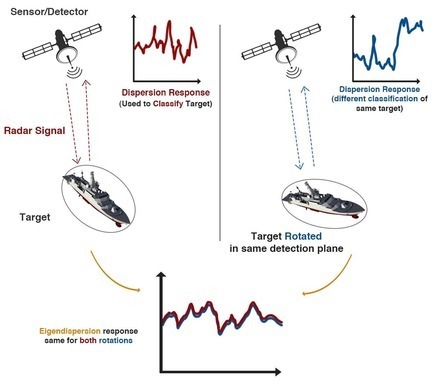Novel Method for Rotation Invariant Characterizations
Tech ID: 19-033
Inventor: Dr. Thomas Pratt
Date added: January 12, 2021
Overview
Novel signal processing method to allow radar target recognition regardless of antenna or target rotation.
Technology Summary
Polarization features are often utilized to facilitate classification in radar imaging and target classification applications. In target classification, an antenna directs radio-frequency (RF) energy at an object and identifies the object based on the detected response of RF energy reflected from the target. More accurate target classification information can also be produced from polarization of the RF energy. This polarimetry technique assumes that the polarization basis of the transmitted (TX) and received (RX) RF signals does not vary, except for the polarization transformation induced by the reflection of energy off the target. Additionally, responses that are invariant to roll orientation in respect to their position to the antenna are desirable to facilitate consistent target responses. Coherent target scattering matrix, the Mueller matrix, target covariance matrix, and incoherent decompositions are approaches for distinguishing radar targets. However, these methods face issues such as parameter ambiguity problems, exhibit responses that vary with the antenna polarization basis, and inability to achieve roll-invariance for asymmetric targets.

Researchers at the University of Notre Dame have recently developed a novel signal processing method for characterizing specific target responses for a wide-range of applications such as naval vessel classification, turbomachinery foreign object detection, medical vital sign monitoring, industrial vibrometry, and buried object classification. This technique operates via the same polarization-related quantities used in traditional polarimetry and performs an analysis of these quantities to produce a rotation-invariant response for target classification of both symmetric and nonsymmetric targets.
Market Advantages
• Allows targets to be classified consistently based on their dispersion response, regardless of their rotation relative to the sensing antenna.
• Applicable to both symmetric and non-symmetric targets.
Market Opportunity
• Geoscience & remote sensing for naval vessel characterization - $2.7B Market
• Industrial vibrometry - $1.04B Market
• Turbomachinery foreign object detection - $205M Market
• Non-contact vital sign monitoring - $3.4B Market
• Ground penetrating radar – $144.5M Market
Technology Readiness Status
TRL 3 – Experimental Proof of Concept
Contact
Richard Cox
rcox4@nd.edu
574.631.5158